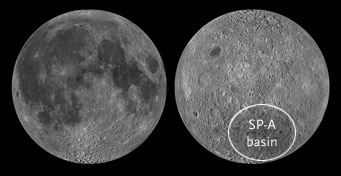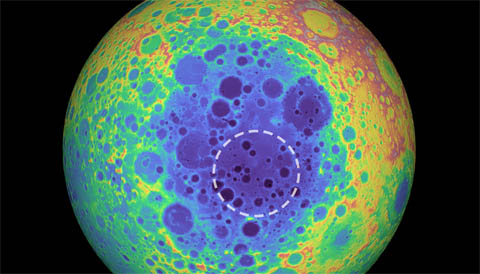Does the massive metallic core of a primordial impactor lie buried under the South Pole-Aitken basin on the lunar farside?
One of the Moon's most fascinating features — one hidden from our view on its farside — is a huge impact basin known as South Pole-Aitken (SPA). It's so named because its 2,400-km (1,500-mile) diameter extends from the crater Aitken on its north rim to the lunar south pole. It's immense, second only to Mars' Hellas basin as the largest impact in the solar system.

NASA / Arizona State Univ.
SPA isn't particularly obvious in spacecraft photos — a somewhat darker center hints of metal-rich material dredged up from the Moon's deep crust or uppermost mantle. But topographically it's an unmistakable pit up to 9 km deep. Early this year China's Chang-e 4 lander dropped onto one particularly deep spot near the basin's center.
Geologists have long suspected that oval-shaped SPA resulted from the slow, oblique collision of an object roughly 200 km across that didn't penetrate the Moon very deeply.
Now an analysis of gravity and topography data has identified a huge mass buried under the basin. A team led by Peter B. James (Baylor University), which announced the discovery in Geophysical Research Letters, combined topographic maps of the basin with the best-available data from NASA's Gravity Recovery and Interior Laboratory (GRAIL) mission. The team suspects that the impactor's iron-rich core might have dispersed itself in the Moon's upper mantle, leaving behind a concentrated blob with roughly five times the mass of the Big Island in Hawai'i.
Mass concentrations (or mascons) are nothing new — they're typically found under many other lunar basins. But those tend to have a bull's-eye structure with a deeply buried ring of lower-density material sandwiched between a denser core and outer ring. This tells researchers that that the impact removed enough overlying crust to allow a "plume" of dense, metal-rich mantle to rise toward the surface under the basin's center.

NASA / Goddard Space Flight Center / Univ. of Arizona
But the massive blob buried some 400 km under SPA has a different gravitational fingerprint. James and his colleagues posit that it could be a holdover from the Moon's formation, a concentration of dense metallic oxides created as the last of a deep, global magma ocean cooled and solidified. But why aren't these vestiges seen elsewhere? And why would such a huge one just happen to lie beneath the largest lunar impact basin?
A more plausible explanation for this excess mass, James notes in a Baylor press release, is that "the metal from the asteroid that formed this crater is still embedded in the Moon’s mantle." The SPA impactor most likely would have had a differentiated (layered) structure with a silicate exterior and an iron-nickel core. The team's computer simulations show that, after striking the Moon with a glancing blow, the impactor's metallic core could have ended up as a lump beneath the basin — concentrated enough to create the gravity anomaly recorded by GRAIL, but dispersed enough that it didn't sink en masse toward the lunar core.
Researchers are still gauging how the largest and deepest lunar impact basin affected the rest of the Moon when it formed some 4 billion years ago. For sure, it redistributed huge volumes of crust all around the lunar globe. And it's been implicated in creating magnetic anomalies all over the lunar surface. SPA's formation might also have altered the Moon's rotation. Now dynamicists will be looking closely to see what role this massive, newly discovered lump might have played in altering lunar history.
 0
0
Comments
You must be logged in to post a comment.